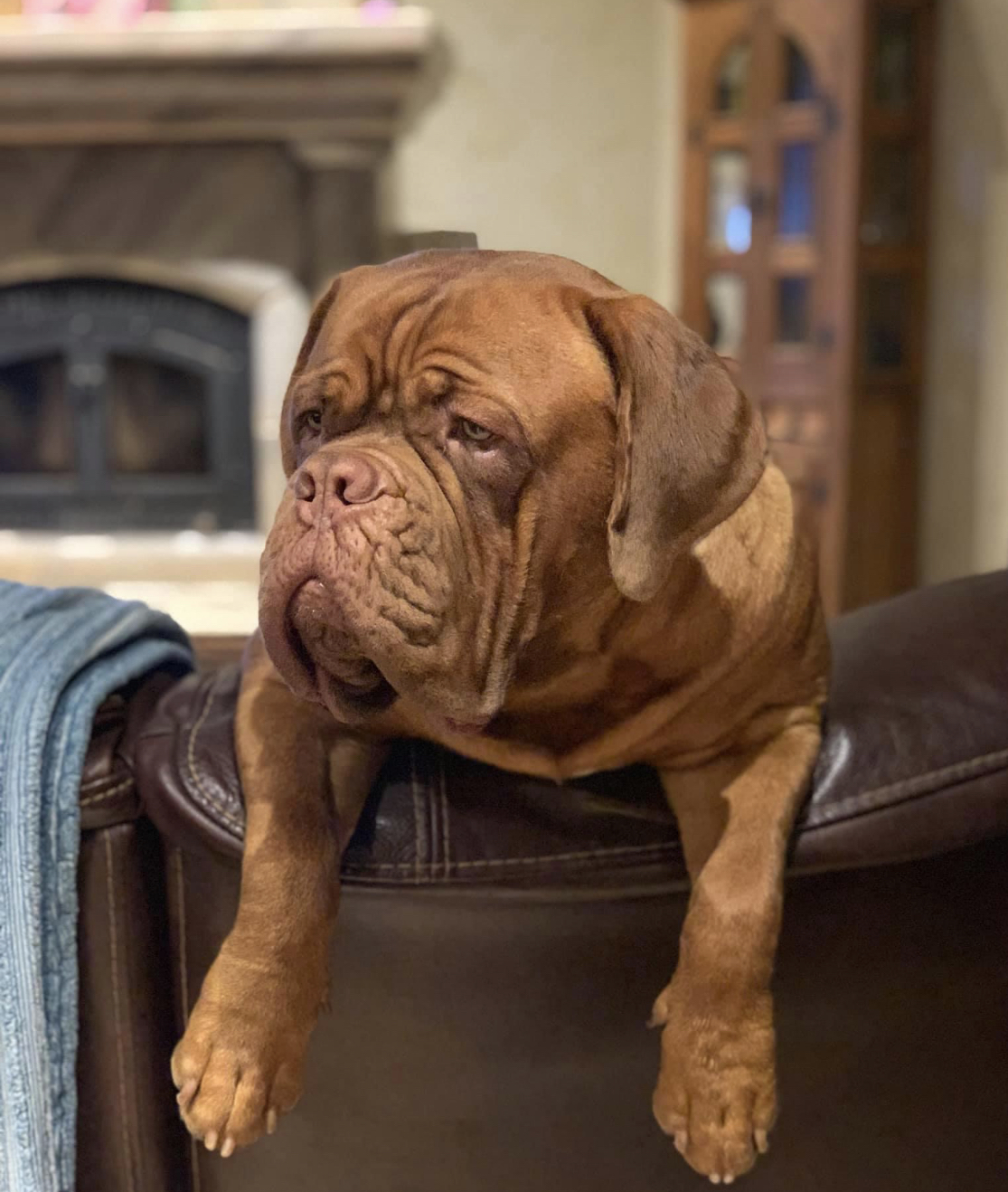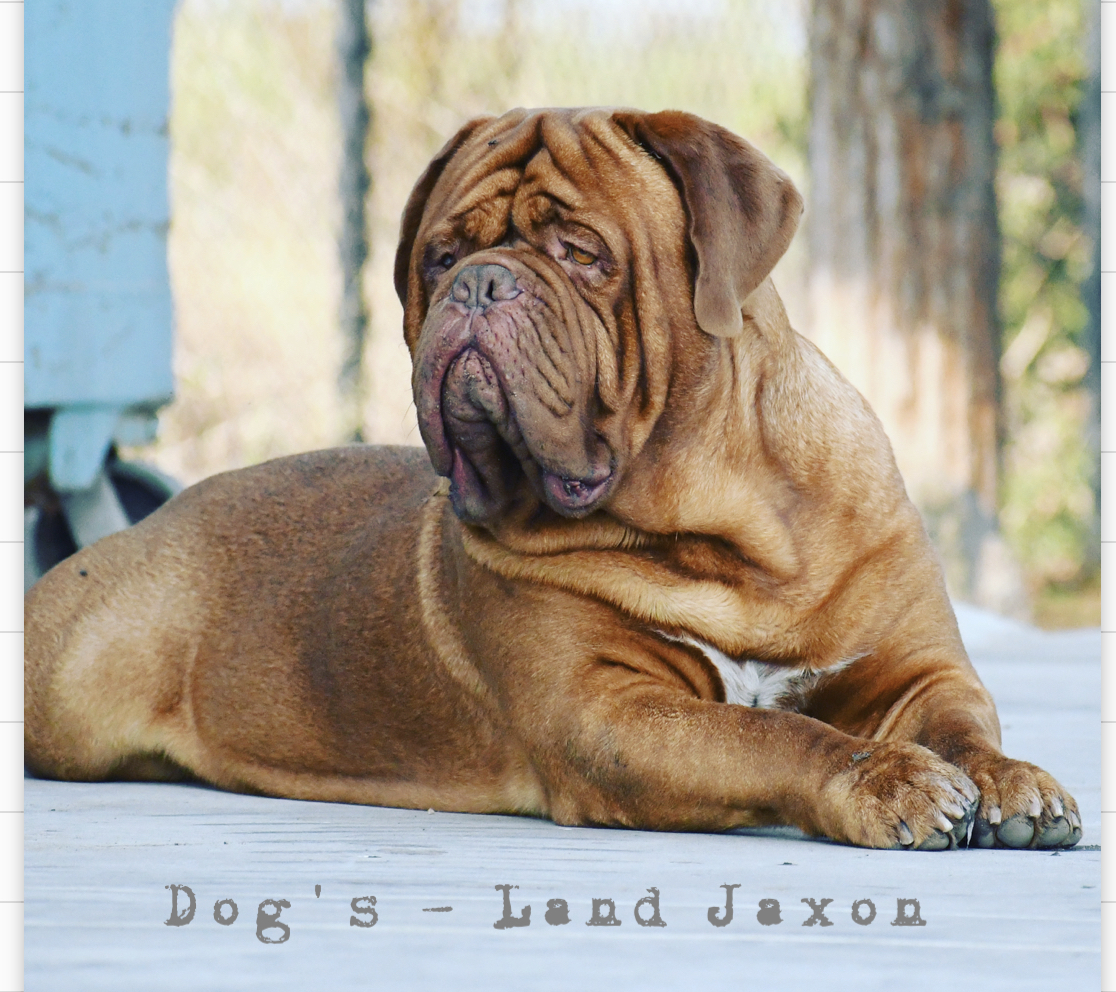 TRAINING MYTHS
TRAINING MYTHS
MYTH: Positive Reinforcement Training Is Effective With Smaller, Cooperative Dogs. Not Large, Stubborn Dogs
THE REAL DOGUE DE BORDEAUX FACTS: Quite the contrary! It is the consensus among researchers that using aversive training methods on fearful or aggressive dogs is more likely to lead to worse behaviors. In contrast, focusing on rewarding your dog and alleviating their anxieties leads to a more well-adjusted dog. One size does not fit all when it comes to training. You must find the correct formula of training that is right for your Dogue de Bordeaux. We highly recommend clicker training, it yields wonderful results.
 MYTH: A Dogue De Bordeaux Puppy Must Be Six Months Old Before Training Starts
MYTH: A Dogue De Bordeaux Puppy Must Be Six Months Old Before Training Starts
THE REAL DOGUE DE BORDEAUX FACTS: Some trainers will refuse to work with puppies younger than six months because their training is based on collar corrections and other disciplinary techniques. The puppy must therefore be old enough to safely withstand the corrections without injury. Yet, with positive reinforcement techniques you can begin working with your baby the day you bring him home and it is much more successful than the “old school” methods. Puppies have a very small window of time during brain development when they are most impressionable called the “imprinting period”. The imprinting period lasts until the puppy is 16 weeks old. They are capable of learning more in this time frame than they will be for the rest of their lives! It only makes sense that you begin teaching your puppy before this window closes. Begin socializing them as well. True, puppies have a much shorter attention span than adolescent/adult dogs. Keep training sessions brief. Be patient when teaching commands. The sooner you begin working with him, the quicker he will learn. You will find that a behavior learned during the imprinting period will never be forgotten by your Dogue de Bordeaux.
MYTH: Rubbing Your Dogue De Bordeaux’s Nose In A Potty Accident Will Housebreak Him Faster
THE REAL DOGUE DE BORDEAUX FACTS: NO NO NO! Understand that punishing a dog by yelling or disciplining him for such a normal behavior like going to the bathroom only discourages the dog from going potty in front of you. Next time he will find a spot out of sight in the house to go. Or, he may not even want to make outside when you take him because he is afraid to go potty with you watching. Instead, PRAISE PRAISE PRAISE your Dogue de Bordeaux puppy when they go in the appropriate spot. Realize that house training takes months not days. Have an age appropriate potty schedule. Pick up on your puppy’s cues when he has to go out. Completely clean up any accidents. When a dog smells the scent of urine his natural urge is to cover the spot with fresh pee.
 MYTH: Bad Behaviors Like Pulling On Leash, Jumping Up, Sitting On Couch & Bed Are Signs Of A Dominant Attitude
MYTH: Bad Behaviors Like Pulling On Leash, Jumping Up, Sitting On Couch & Bed Are Signs Of A Dominant Attitude
THE REAL DOGUE DE BORDEAUX FACTS: If a dog is doing these things it does not necessarily mean he is being strictly dominant. More than likely the cause is a lack of proper training. If you do not want a 120 lb Dogue de Bordeaux on your brand new duvet cover, then do not allow your 3 month old puppy on the bed. You can shape your adult dog’s behavior, but you must be consistent. Otherwise your Dogue de Bordeaux will not know what you expect of him. Now these can be signs of dominance. If you suspect this to be the case, you have to evaluate the situation quickly. A dog does not learn dominant behaviors overnight so you must re-train yourself and take leadership back.
HEALTH MYTHS
FACT & MYTH: The Dogue De Bordeaux Is An Unhealthy Breed
This statement is both true and false because speaking about the health of a breed overall is very relative.
It is a myth to say every individual Dogue de Bordeaux is unhealthy. There are many, many health ambassadors of our breed that epitomize a healthy, athletic, robust dog.
At the same time, it would NOT be accurate to describe the Dogue de Bordeaux as “healthy”, especially when compared to many other breeds of canines.
True, every single dog breed is predisposed to some sort of health issue. Siberian Huskies seem to be predisposed to autoimmune disorders, Pugs are at risk for eye problems, Labrador Retrievers are prone to obesity, Epilepsy is more common in Beagles than any other breed, patellar luxation (wobbly kneecaps) are extremely common in toy breeds like the Shih Tzu, Dachshunds are at a higher risk for back problems, Miniature Schnauzers seem to be at a higher risk to develop diabetes, dilated cardiomyopathy (a heart condition) is so common in Doberman Pinschers that veterinarians recommend annual screenings to Doberman owners. Still, it seems the Dogue de Bordeaux is predisposed to WAY more than its fair share of serious health concerns.
Hence, it is extremely important for any potential Dogue de Bordeaux owner to familiarize themselves with these conditions and understand the potential for them to develop in ANY Dogue de Bordeaux, regardless of the line, pedigree, breeder, or testing of ancestors.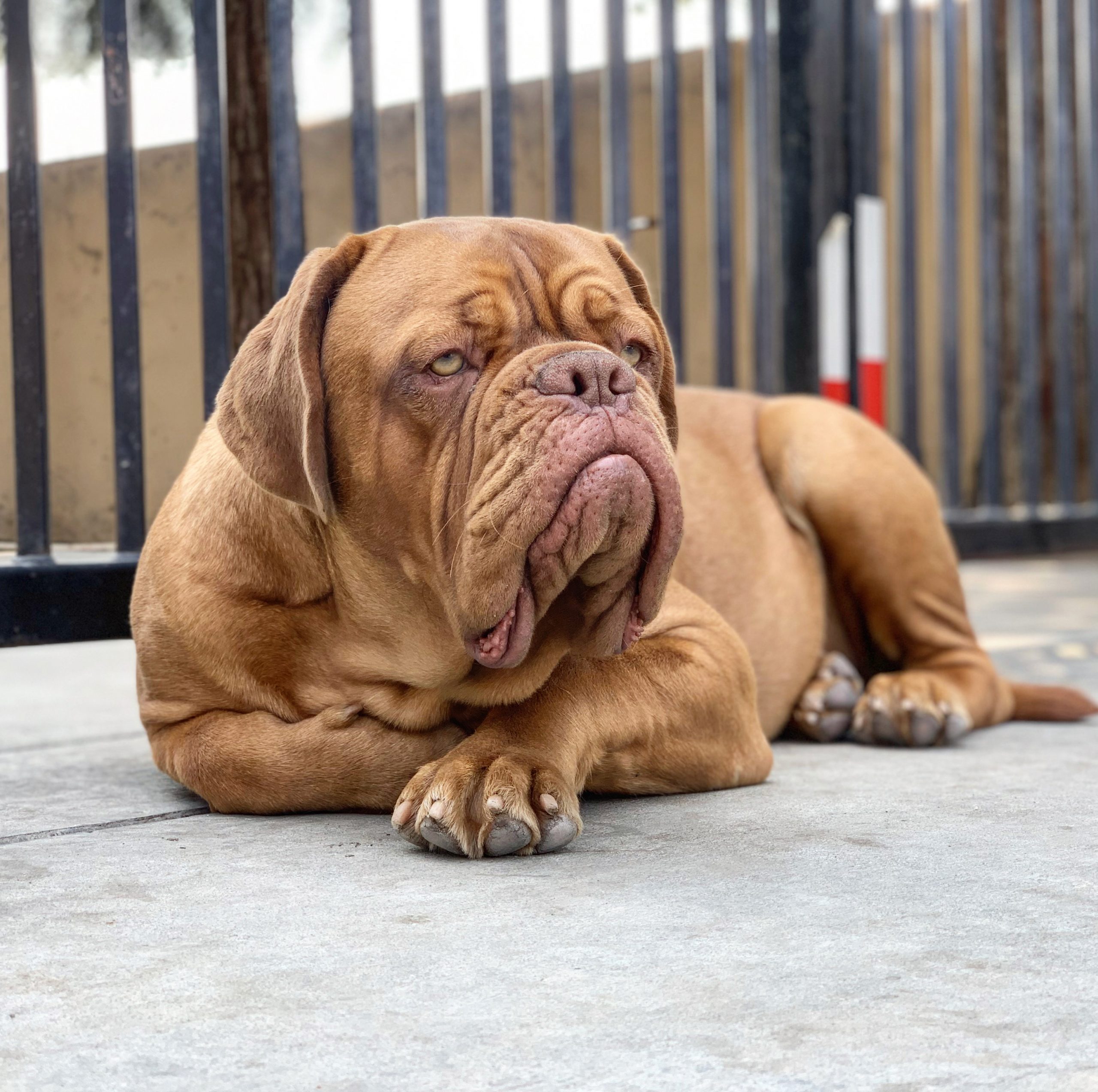
HEART DISEASE
A major and very devastating issue in this breed are malformations of the heart or the great vessels. Many congenital heart defects are thought to be genetically transmitted from parents to offspring; however, the exact modes of inheritance have not been precisely determined for all cardiovascular malformations. Conditions genetic in nature are often present at birth, though some present later in life. Sometimes, juvenile mild heart murmurs are only present in young puppies because the heart was not completely developed at birth and they are often outgrown, but not always.
Heart disease manifests itself in the Dogue de Bordeaux in the forms of:
- SAS (Subvalvular arotic senosis)
- DCM (Dilated Cardio myopathy)
- Aortic Stenosis
- Hole in the Heart (Atrial Septal Defect)
- Pulmonic Stenosis
- Mitral Dysplasia
- Mitral Stenosis
ORTHOPEDIC AND NEUROLOGICAL PROBLEMS
- HIP DYSPLASIA
- ELBOW DYSPLASIA
- SHOULDER DYSPLASIA
The Dogue de Brodeaux, like all large / giant breeds, are predisposed to these orthopedic diseases. In fact, the Dogue de Bordeaux currently ranks number 3 on OFA’s (Orthopedic Foundation for Animals) hip dysplasia statistic list. Meaning only 2 other breeds were found to have more incidences of the disease. It is important for potential owners to know environmental factors can AND DO cause these orthopedic problems just as much as genetics. See below for more information on hip dysplasia.
- CRUCIATE TEAR / RUPTURE (ACL)
Ocurring when the ligament inside the knee joint is injured causing it to tear or rupture. This injury is very noticeable. You will see acute lameness on the impacted leg. Typically, surgical correction is required. Although, many have opted for a conservative management first. LOTS of rest, absolute minimal exercise, various joint and ligament supplements, pain medication as needed, etc. Such an injury can take at least 6-9 months to heal without surgery. After which the scar tissue supports the joint allowing for weight bearing and movement again. A torn cruciate has absolutely nothing to do with genetics. It is an injury.
- PANOSTEITIS (Pano)
Often times referred to as “growing pains”. Most commonly seen between the ages of 6 to 16 months. Pano is caused by excessive bone production on the long bones. Normally, a dog affected by this condition will grow out of the problem, but it is painful. The exact cause is unknown although genetics, diet, stress, infection, and metabolic or autoimmune problems
have been suspected.
Lameness can occur in one limb or over time in all limbs. It often is intermittent affecting one leg then another and back again… It is self-limiting and spontaneously disappears.
- HYPERTROPHIC OSTEDYSTROPHY (HOD)
A developmental disorder that manifests with toes turning in or out, roached toplines, pinched rears, and in advanced stages fever, lethargy, pain in joints, inability to stand or function. This is a problem presumed at this time to be of intake in calories versus output of energy – too many calories consumed and/or unbalanced diet disrupted by supplementing.
- WOBBLER SYNDROME (Pondylomyelopathy, Cervical Vertebral Instability, Cervical Vertebral Malformation, and Cervical Spondylopathy)
Wobbler syndrome is a disease in which the spinal cord and nerve roots are compressed in the area of the neck due to ligament problems and/or vertebrae malformation. Symptoms of Wobbler’s include limb weakness or even paralysis, difficulty rising after sitting or lying down, muscle loss through the shoulders, increased extension of limbs and worn nails from foot dragging. This is believed to be an inherited genetic disorder with environmental influence. Rapid growth and nutrition may influence the expression of the disease.
EYE PROBLEMS
- ECTROPIAN
- ENTROPIAN
- CATARACT
OTHER PROBLEMS IN THE BREED
- CANCER
- ALLERGIES
- EPILEPSY
- HYPOTHYROIDISM
- BLOAT a/k/a Gastric Dilatation Volvulus (GDV) is a life threatening condition that is seen in large, deep chested breeds like the Dogue de Bordeaux. Bloat is a condition caused by a twisting of the stomach and thus trapping the stomach contents and gases resulting in a rapid swelling of the abdomen accompanied by pain and eventual death if untreated. You should have an emergency plan in place should you notice the symptoms of bloat in your pet. Bloat preventative measures than you can take are:
- Do not feed your dog from elevated dishes. It was once thought that raising the the food and water dishes would decrease the risk of bloat. However, a study of canine bloat has shown that the height of your dog’s bowls may play a role in GDV.
- Do not allow your Dogue de Bordeaux to gulp down his meals. If your dog scarfs down his food, he will swallow a lot of air in the process. This is a crucial contributing factor in GDV. Use a stainless steel slow feeder bowl.
- Do not allow exercise before meals (at least one hour) and especially after meals (at least 2 hours).
- Do not allow your dog to drink a large amount of water after eating. Take your pet’s water away during meal times.
- If there are other pets in the home, feed the dogs in separate rooms. A dog’s natural instinct is to eat the available food before another dog can get to it. This feeling of competition will make your Dogue de Bordeaux gulp down his food faster than he would normally if there weren’t another dog right there.
- Avoid dry kibble that contains carbohydrates like corn, wheat, rice, soy and oatmeal. These carbs are highly fermentable, and fermentation produces gas. If the gas becomes trapped in your dog’s stomach, then in theory, your dog will be more prone to develop bloat. So, feed your dog a kibble that is low in carbs, or uses low-glycemic sources of carbohydrates such as fruits and vegetables. Acana dog feed is the absolute best counterpart to a BARF diet and it is what we feed here at Almond Blossom Bordeaux.

MYTH: Hip Dysplasia In The Dogue De Bordeaux Is The Exclusive Result Of Irresponsible Breeding
THE REAL DOGUE DE BORDEAUX FACTS: Hip dysplasia is one of the most common skeletal diseases in dogs and is the most common problem of the Dogue de Bordeaux. When a dog is diagnosed with hip dyslpasia owners are often led to believe it is solely the result of bad breeding by sub par, backyard breeders who give no thought to the health of their breeding stock. In actuality, hip dysplasia is caused by a number of genetic and environmental factors. Some dogs can be born with the condition, referred to as early on set hip dysplasia. Dogs can develop the disease in later years with the onset of arthritic conditions, later onset hip dysplasia. Environmental factors including rapid weight gain, obesity, nutritional factors, poor hind limb muscle development, pelvic injuries, or repetitive strain injuries can cause hip dysplasia. Because of the multiple genes involved, even two dogs with good hips can produce puppies with severe hip dysplasia. For all of these reasons it is impossible to eliminate the condition from the breed.
 MYTH: A Dogue De Bordeaux Diagnosed With Hip Dysplasia Is Crippled. The Only Hope Is Surgical Intervention
MYTH: A Dogue De Bordeaux Diagnosed With Hip Dysplasia Is Crippled. The Only Hope Is Surgical Intervention
THE REAL DOGUE DE BORDEAUX FACTS: There are varying degrees of hip dysplasia. The Orthopedic Foundation for Animals (OFA) has 7 phenotypic categories for rating hip dysplasia. They range from excellent to severe. That does not mean a dysplastic dog cannot live a long, happy life. If you saw a mildly dysplastic Dogue de Bordeaux playing with a group of other dogs, you would have no idea of his condition unless you were told because he would be running, jumping and playing like all the other dogs. Do not misunderstand, it is by no means a condition to be ignored. If a dog is diagnosed you must act accordingly with respect to nutrition, exercise and therapy. But, it is important for us all to realize that hip dysplasia does not signal the end of a normal life for your dog. We agree it is not an issue that should be swept under the rug and that is why we have included this information on our website (many breeders do not). We wish to help inform people.
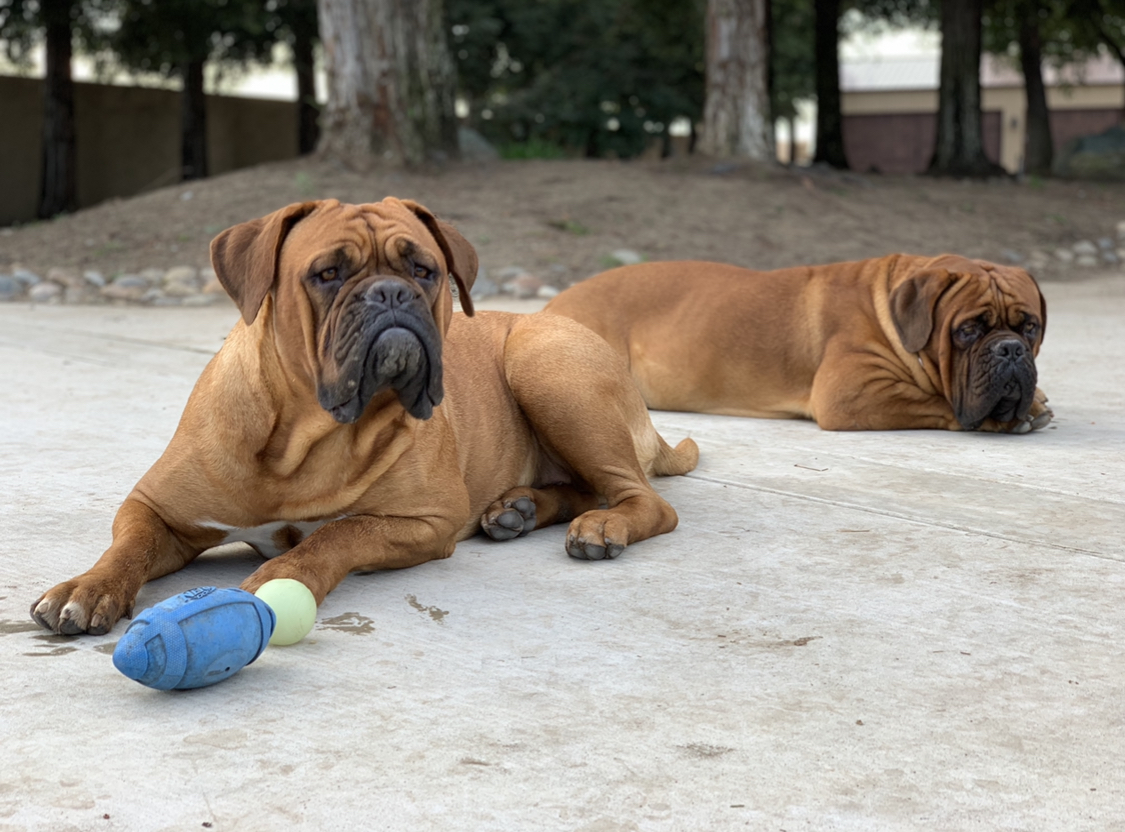 FACT: Dogues De Bordeaux Have Short Lives
FACT: Dogues De Bordeaux Have Short Lives
This is a common statement made about the Dogue de Bordeaux and sadly it is a true one. The average life span of a Dogue de Bordeaux is 6 to 8 years. From time to time you may see a Dogue de Bordeaux live to the age of 10, but that is not the norm. The oldest Dogue de Bordeaux recorded in an American survey was 12 years old. For many this is a deal breaker when considering acquiring a Dogue de Bordeaux. Thus it bears discussion.
In nature larger animals tend to live longer. The elephant, the blue whale, even horses have a much longer life expectancy than smaller species. In dogs, this trend reverses. Why? All research that has been done seem to point to the same conclusion. In short, large dogs age quicker. Their adult lives appear to unravel in fast motion. If this is because of the increased health issues large breeds are prone to, or due to their fast growth rate, is uncertain. In a European study, researchers analyzed data on age of death in over 56,000 dogs from 74 different breeds. Their findings were: For every increase of 4.4 lbs of body weight, a dog’s lifespan decreased by 1 month. In any event, the relationship between size and lifespan is not completely understood. More studies need to be done in order to pinpoint the definitive scientific cause.
For most of us the death of a beloved friend and pet is devastating no matter the age of the dog. Whether you lose a Dogue de Bordeaux at the age of 8 or a Chihuahua at the age of 15, it always seems much much too soon. We Dogue de Bordeaux lovers who have owned the breed understand the need to value each and every day we get to share with them.
PUPPY MYTHS
MYTH: The More You Feed A Dogue De Bordeaux, The Bigger He Will Grow To Be
THE REAL DOGUE DE BORDEAUX FACTS: How big a puppy will eventually get depends entirely upon genetics. Looking at the sire and dam and researching their lines will give you a fair accurate idea of what your puppy will look like full grown. Sadly, some are under the impression that if they feed their Dogue de Bordeaux puppy a lot of food rich in calories, calcium, and protein this will impact how large he will grow to be. Calcium and calories are actually the two things you MUST avoid! A fast growing Dogue de Bordeaux puppy is not a positive thing for the health of the dog. Over feeding will only hurt your growing pup by making him fat. Excess weight can cause diabetes, joint health problems and a slew of other issues.
Your choice of puppy feed will be critical to the skeletal development of your Dogue de Bordeaux puppy. You must put your Dogue de Bordeaux puppy on a controlled, grain-free diet that is low in calories and calcium. Do not free feed or feed liberal meals that exceed their daily caloric need. Excess calories leads to more rapid growth and excess body weight. These are associated with increased incidence of hip dysplasia, OCD (osteochondrosis dissecans), and elbow dysplasia. Don’t worry, lower calorie diets do not reduce the ultimate stature a dog will achieve, but they reduce the rate of growth so that this size is achieved smoothly over the growth period rather than in a rapid burst. Slow and steady is the name of the game when it comes to the growth of Dogue de Bordeaux puppies. Excess calcium/phosphorus promotes rapid bone growth. Hello! Dogue de Bordeaux puppies’ bones grow fast enough! Too much calcium has been shown to predispose giant breed puppies to the previously mentioned orthopedic issues. Avoid any supplements that contain calcium and/or phosphorus. Though there is some debate on the issue, studies have repeatedly concluded protein levels have no effect on the development of skeletal problems in giant breed dogs.
For more info on Dogue de Bordeaux puppy nutrition see What Should I Feed My DDB Puppy.
 MYTH: A Dogue De Bordeaux Puppy Should Be Allowed To Play As Much As He Likes
MYTH: A Dogue De Bordeaux Puppy Should Be Allowed To Play As Much As He Likes
THE REAL DOGUE DE BORDEAUX FACTS: Your Dogue de Bordeaux puppy has a ton of growing to do. The growth process alone is hard on the pup’s bones and joints. Excessive play/exercise and weight gain exacerbates the discomfort. Your Dogue de Bordeaux puppy should not be allowed to engage in high impact exercises like jumping on the hind legs, jumping on and off furniture, navigating stairs, and high speed running. The stress of these activities can cause trauma on a growing, immature skeletal system and can lead to permanent damage. This is an especially emphasized point with the Dogue de Bordeaux puppy because they have a genetic predisposition to hip dysplasia. Do not allow your puppy to play to the point of exhaustion and never force exercise. For the first few weeks, your puppy’s brief play sessions will be sufficient exercise. As your puppy grows, adding relaxing walks on a leash in increased intervals would be an appropriate exercise. For example, for an 8 month old Dogue de Bordeaux two 10 minute walks a day is more than sufficient. This is difficult because your puppy will be full of energy and dying to do more. Hang in there, you have to do this for their own good. Moderate swimming is a good alternative as well as it is a low impact exercise and Dogues de Bordeaux generally love water. Wait for the growth plates to close, which may not be until 18 months of age, before subjecting them to vigorous exercise. You will not regret it!
MYTH: Anyone Who Can Afford To Purchase A Dogue De Bordeaux Puppy Obviously Makes A Good Home For One
THE REAL DOGUE DE BORDEAUX FACTS: The recipe that makes for a suitable Dogue de Bordeaux home is composed of more ingredients than simply whether or not the check will clear. A reputable Dogue de Bordeaux breeder will screen potential puppy buyers carefully before placing a puppy. A reputable Dogue de Bordeaux breeder will ask you about your family dynamics, your work schedule, your experience with large/giant breeds, a veterinarian’s reference, etc. Do not take offense when you are asked many questions. This means you have found a Dogue de Bordeaux breeder who sincerely cares for the future of the puppy.
CARE MYTHS
MYTH: Any Large Breed Dog Can Be An Outside Dog
THE REAL DOGUE DE BORDEAUX FACTS: It is common knowledge that certain breeds are sensitive to heat and therefore are not suitable outside dogs. When one thinks of a mastiff, they may not realize the same rule applies to them. The Dogue de Bordeaux is a brachycephalic breed. That is, they have a broad skull and short muzzle. It is because of their “pushed in” faces that you may see them mouth breathing, snorting, and snoring from time to time (this should never be constant and they should never be laboring to breath). They can have a tendency to become overheated quickly and because of their brachycephalic build they may be unable to cool themselves as efficiently as other breeds. Do not exercise your dog in the middle of a hot summer day and do not leave him outside without a climate controlled space while you are away. Fortunately however, Brachycephalic Syndrome and other respiratory problems are not common in the Dogue de Bordeaux.
 MYTH: I Have A Big Yard. I Don’t Need To Walk My Dogue De Bordeaux
MYTH: I Have A Big Yard. I Don’t Need To Walk My Dogue De Bordeaux
THE REAL DOGUE DE BORDEAUX FACTS: The Dogue de Bordeaux is a lower energy breed. Nevertheless, they need mental stimulation and physical activity to be balanced. They need to engage in activities with their humans, not by themselves in the backyard. For a dog, walking fulfills a primal need they have, their migration instinct. This is a very therapeutic exercise for people too. A fenced in yard is a wonderful amenity for a Dogue de Bordeaux owner. It provides a safe place for him to play, run, simply enjoy the outdoors. But, it is not interchangeable with a walk.
A couple things to remember – Walks should be kept to appropriate lengths depending on the age of the dog. The Dogue de Bordeaux is not the correct breed for someone looking to go on five mile hikes with their canine. Dogues de Bordeaux tend to have bursts of energy rather than prolonged periods of stamina.
BREED MYTHS
MYTH: Dogues De Bordeaux Are Couch Potatoes
THE REAL DOGUE DE BORDEAUX FACTS: Dogues de Bordeaux are athletes. They are a WORKING breed. They were developed for working, protecting property and hunting. This is not a lazy breed content to hold down the couch all day every day. True, an adult Dogue de Bordeaux should be relatively inactive when inside the home. Yet every component of this breed screams powerful energy, from their muscular body to their keen eyes to their elevated intelligence. The Dogue de Bordeaux loves a job even if it’s just a walk around the block.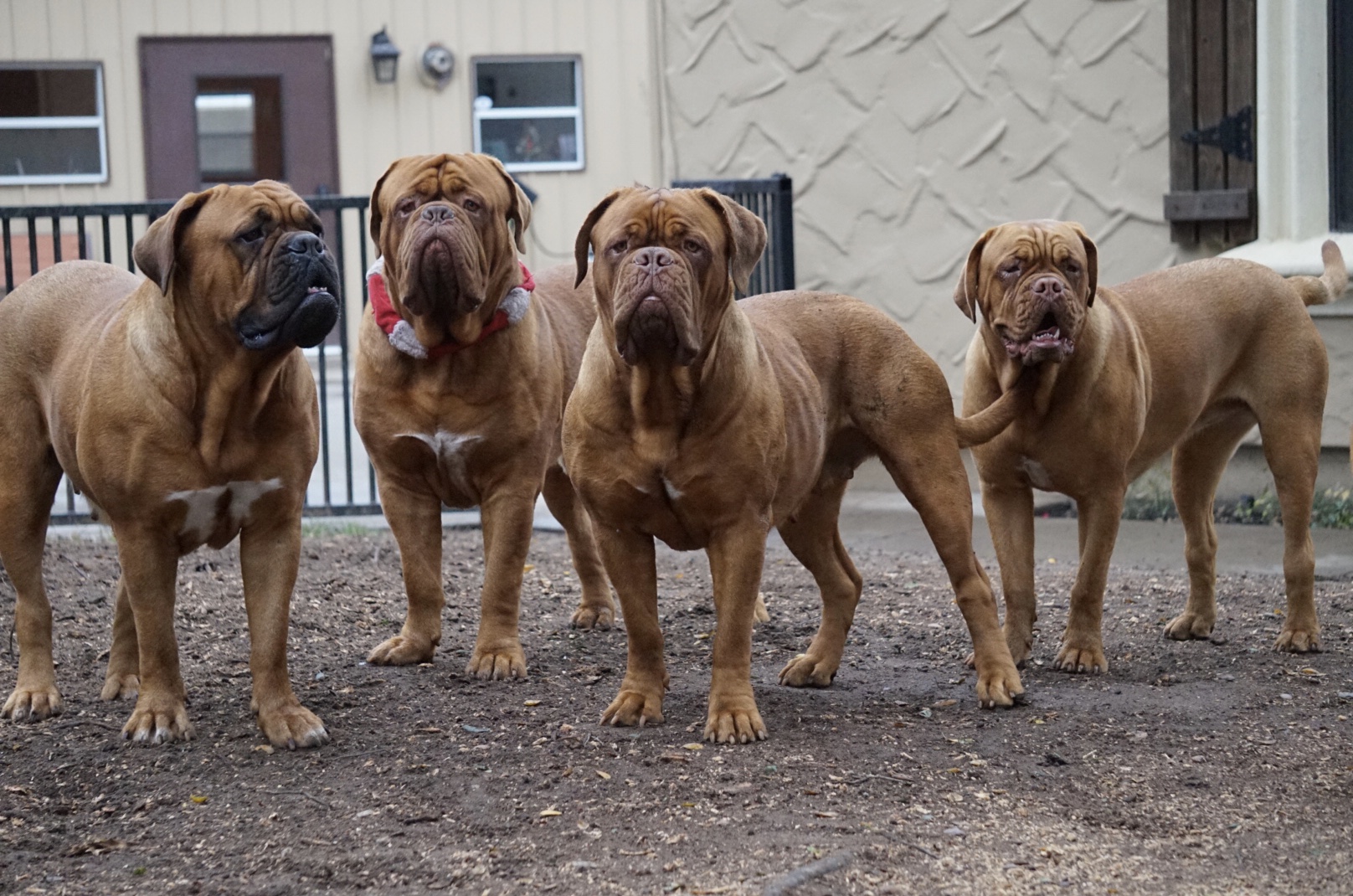
MYTH: All Purebred Dogues De Bordeaux Look The Same
THE REAL DOGUE DE BORDEAUX FACTS: The phenotype of their specimens is just one area where a line is clearly drawn between quality Dogue de Bordeaux breeders and backyard Dogue de Bordeaux breeders . The American Kennel Club and our parent club, the Dogue de Bordeaux Society of America (DDBSA), have published a detailed breed standard. This is the American standard to which all reputable Dogue de Bordeaux breeders hold their breeding stock to. The results are clearly seen when a Dogue de Bordeaux breeder blatantly disregards breed standard. Although no purebred dog can flawlessly reflect the breed standard, it is a blueprint to maintaining the ideal appearance and purpose of the Dogue de Bordeaux.
*WHEN CONSIDERING A BREEDING, THE APPEARANCE OF ANY POTENTIAL PUPPIES MUST COME SECONDARY TO ANY FORESEEABLE HEALTH CONCERNS*




